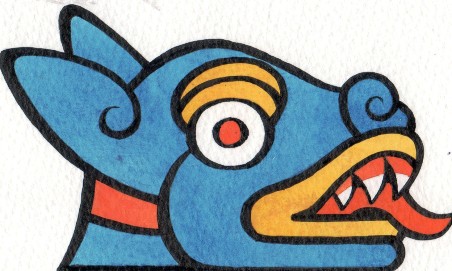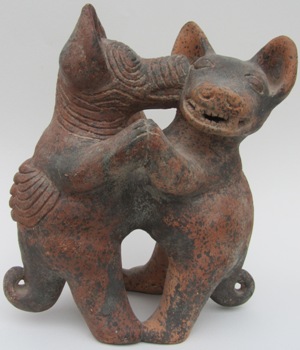A Dog's Dinner

Plump, bandy-legged, well muscled, with a greyish pink rather greasy looking skin, the indigenous “itzcuintli”, also popularly known as Aztec or Colima dog or perro azteca/de Colima, found its way into the cooking pots and onto the banqueting tables of the Aztecs who prized it highly. The hairless dog is an ancient and pure breed, at least 3000 years old, and it is possible that it may have arrived in the Americas in the company of the first migrants who crossed the Bering Straits from Asia. Having seen them – only very occasionally – roaming the dusty streets of small provincial villages during my childhood, I was rather surprised to find from my research that the modern version is actually quite noble and elegant looking, tall, dark and relatively handsome – and that it also comes in a coated variety, with litters containing both hairless and hairy puppies. However, the old Mexican itzcuintli’s rotund shape was a far better indication of its place in the country’s gastronomy and legends.

Itzcuintli © Philip Hood
The full name is xoloitzcuintli and translates as monster dog in the Aztecs’ Náhuatl language. It was sacred and gave its name to the last of the thirteen constellations of the ancient Mexican zodiac. Representing the god of death, Xolotl, it linked the spirit world with that of the living, and having been sacrificed and buried alongside its master, it guided the deceased on their last journey and carried them across the water into the afterlife; in the land of the living, it protected the home and warded off evil forces. It also had a significant reputation as a healer, due perhaps to its beautifully warm bare skin which was said to counteract internal inflammation and soothe the joints, particularly when the dog acted as a hot water bottle in the sufferer’s bed! The itzcuintli was kept by many of the pre-Columbian Mexican peoples - Mayas, Aztecas, Toltecas, Zapotecas and Colimaenses in particular – and therefore also appears frequently in ancient art, particularly in the form of clay and pottery figurines and statues, like the dancing dogs of Palenque and Colima. The famous Mexican artist, Frida Kahlo, kept several pet itzcuintlis and her painting, “The Love Embrace of the Universe”, actually features a little hairless dog.

Itzcuintlis Bailarines © Isabel Hood
While the xoloitzcuintli breed has been part and parcel of Mexican culture for millennia, it was very rare beyond the national borders. It was formally entered into the American Kennel Club studbook as early as 1887 but it attracted little attention at home and was edging its way towards extinction in the twentieth century. In the mid 1950s, organised breeding programmes were established and Columbus’ strange hairless dog eventually became the official dog of Mexico.
As for the xoloitzcuintli's role in the ancient Mexican cooking pots, the journals written by Christopher Columbus are said to bear mention of “strange hairless dogs” while the Spanish Conquistador, Hernán Cortés, reported the presence of little dogs bred as food both in the great market of Tenochtitlán and in the hands of street vendors elsewhere; subsequently other Spanish chroniclers recorded their existence and the regular incidences of dog meat as part of the meals of noblemen and priests. I have been unable to find any actual recipes or reports as to how the itzcuintlis were cooked but there is evidence of large numbers of dogs, bred and fattened specifically for human consumption, being served at royal banquets and for religious festivals, often combined with turkey meat. The most likely method of cooking was probably in pozole, a very traditional, historical and pre-Hispanic soupy maize stew but I like to think of the chubby little itzcuintli being slowly braised in a rich “mole” sauce, fragrant with dried chillies, nuts and roasted tomatoes, thickened with corn, and deepened perhaps with an exotic, sultry hint of chocolate.

The full name is xoloitzcuintli and translates as monster dog in the Aztecs’ Náhuatl language. It was sacred and gave its name to the last of the thirteen constellations of the ancient Mexican zodiac. Representing the god of death, Xolotl, it linked the spirit world with that of the living, and having been sacrificed and buried alongside its master, it guided the deceased on their last journey and carried them across the water into the afterlife; in the land of the living, it protected the home and warded off evil forces. It also had a significant reputation as a healer, due perhaps to its beautifully warm bare skin which was said to counteract internal inflammation and soothe the joints, particularly when the dog acted as a hot water bottle in the sufferer’s bed! The itzcuintli was kept by many of the pre-Columbian Mexican peoples - Mayas, Aztecas, Toltecas, Zapotecas and Colimaenses in particular – and therefore also appears frequently in ancient art, particularly in the form of clay and pottery figurines and statues, like the dancing dogs of Palenque and Colima. The famous Mexican artist, Frida Kahlo, kept several pet itzcuintlis and her painting, “The Love Embrace of the Universe”, actually features a little hairless dog.
While the xoloitzcuintli breed has been part and parcel of Mexican culture for millennia, it was very rare beyond the national borders. It was formally entered into the American Kennel Club studbook as early as 1887 but it attracted little attention at home and was edging its way towards extinction in the twentieth century. In the mid 1950s, organised breeding programmes were established and Columbus’ strange hairless dog eventually became the official dog of Mexico.
As for the xoloitzcuintli's role in the ancient Mexican cooking pots, the journals written by Christopher Columbus are said to bear mention of “strange hairless dogs” while the Spanish Conquistador, Hernán Cortés, reported the presence of little dogs bred as food both in the great market of Tenochtitlán and in the hands of street vendors elsewhere; subsequently other Spanish chroniclers recorded their existence and the regular incidences of dog meat as part of the meals of noblemen and priests. I have been unable to find any actual recipes or reports as to how the itzcuintlis were cooked but there is evidence of large numbers of dogs, bred and fattened specifically for human consumption, being served at royal banquets and for religious festivals, often combined with turkey meat. The most likely method of cooking was probably in pozole, a very traditional, historical and pre-Hispanic soupy maize stew but I like to think of the chubby little itzcuintli being slowly braised in a rich “mole” sauce, fragrant with dried chillies, nuts and roasted tomatoes, thickened with corn, and deepened perhaps with an exotic, sultry hint of chocolate.
You Should Also Read:
Safeguarding Mexico's Historical Cuisine
The Spanish Influence in Mexican Cuisine
New Year in Mexico - Pozole Recipe

Related Articles
Editor's Picks Articles
Top Ten Articles
Previous Features
Site Map
Content copyright © 2023 by Isabel Hood. All rights reserved.
This content was written by Isabel Hood. If you wish to use this content in any manner, you need written permission. Contact Mickey Marquez for details.


